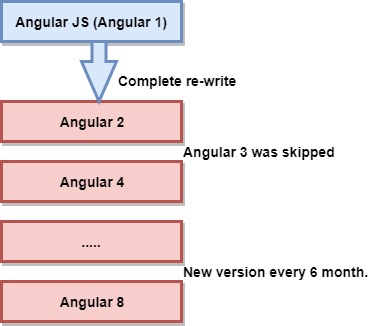History and Versions of Angular 8
Introduction to Angular JS
Misko created Angular JS and the first version of Angular also name as "Angular 1". He built a framework to handle the downfalls of HTML. The first version of the structure, known as Angular JS, was launched in the year 2009. It is one of the best single-page application development solutions.
Features of Angular JS
- Allows easy event Handling.
- Support for data binding.
- Built-in Template Engine and Routing
- Form validation and animations
- Dependencies Injection
- A JavaScript MVW Framework
Introduction to Angular 2
After releasing Angular JS, Angular team released that Angular 2 which is a complete rewrite of its original Angular 1. Angular 2 version is built in the concept of the component. It offers better performance to web developers.
Some Essential Features of Angular 2 are:
- New, faster, and highly scalable framework.
- Useful for web, mobile, and desktop apps.
- Support hierarchical dependency injection.
Why not Angular 3?
In Angular 3 all packages names were assigned version 2, but router package by mistake was given version 3 so that, the development team skipped Angular Version 3 and directly named it Angular 4 to maintain compatibility.
Introduction to Angular 4
There are only a few changes and some new features added in it. It supports Typescript, which compiles to JavaScript and displays the same thing in the browser.
This Version has some additional features:
- This version introduced the Http Client, a smaller, easier to use, and more powerful library for HTTP Requests.
- It provides a new router and life cycle events for Guards and Resolvers. Four new games: GuardCheckStart, GuardsCheckStart, Guardschecked, resolved to join the extent set of life cycle event like Navigation Start.
- It provides the support of disabling animations.
- Reduce the size of the generated bundles code up to 60%
- Supports for if/else statement
- Support for email validation.
Introduction to Angular 5
Angular 5 doesn’t bring significant change from Angular 4. But lots of features and many new improvements are done in the versions.
Features of Angular 5
- Make default AOT
- More comfortable to built attractive web pages
- Type checking in templates
- It supports international number, date, and currency pipes.
- New router lifecycle events.
- Lambda Support
Introduction to Angular 6
Angular 6 is a JavaScript framework for building interactive web applications and Typescript, which is a super-set of JavaScript. It provides build-in features for animation, HTTP service, and materials such as auto-complete, navigation, toolbar, menus, etc.
Introduction to Angular 7
Angular is a framework which is used to build mobile and web applications. Angular 7 mainly focuses on the Ivy project, rewriting the Angular 7 primarily concentrate on Ivy project.
Features of Angular 7
- CLI prompts
- Application performance
- Angular Material and CDK
- Improved Accessibility
- Angular elements
- Dependency updates
- Ivy progress
Introduction to Angular 8
Angular 8 supports for web workers. There are also many features included there to improve our productivity.
Attractive Features of Angular 8
- Preview of Angular Ivy
- Router backward compatibility
- Opt-in usage sharing
- Lazy loading
- Service workers
- Bazel support
- CLI Workflow environment.

History of Angular
History of Angular 1
The first version of Angular is Angular1.0 is also known as Angular JS, which was released in 2010. It was mainly designed for single-page web apps which were owned by Google.
History of Angular 2
Angular2.0 was introduced in October 2014. It was the same as Angular, so the changes in 2.0 created controversy among developer. On April 30, 2015, the Developers Announced that Angular2 moved from Alpha to Developer preview and beta version was released on December 2015. Its first version was published on May 2016, and the last version was released on September 14, 2016.
History of Angular 4
Angular4 versions were announced on December 13, 2016. The developer skipped version 3 due to some confusion. It was released on March 23, 2017. It is compatible with most of the applications, and it provides better bug fixed, and alerts compare to Angular 2.
History of Angular 5
The version of Angular was released on November 17, 2017. It provided some improvements to support progressive web apps, also includes development. It was small in size and faster as compared to the previous version of Angular that is angular4. There is an Angular Universal State Transfer (UST) also given that supports API and DOM.
History of Angular 6
It was released on May 2008. The various features have come with the release of angular 6 are follows:
- Updating in a lean command-line interface.
- We are updating in a Component development kit.
History of Angular 8
The latest version of Angular is Angular 8. It was released on October 18, 2018. It has many incredible characteristics.
- Updates regarding Application Performance
- Angular Material & CDK
- Virtual Scrolling
- Improved Accessibility of Selects
- Supports Content Projection using web standard in custom elements.